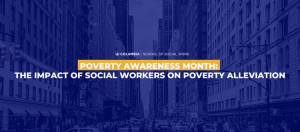This past January was Poverty Awareness Month, a month-long initiative to raise awareness and call attention to the growth of poverty in America. Factors that contribute to poverty include housing costs, education, safety, and justice.
In May 2015, Columbia School of Social Work launched the Center on Poverty and Social Policy. Ginsberg Professor of Contemporary Urban Problems Irwin Garfinkel, and research scientist Christopher Wimer co-direct the center and provide opportunities for the faculty at CSSW, many of whom are studying economically vulnerable populations, to focus even more of their attention on social policies that will help to reduce poverty and increase economic security in the United States.
Dr. Garfinkel and Wimer are behind some of CSSW’s most cutting-edge research findings on the causes of poverty and economic insecurity. They have discovered various policies and programs that would decrease the poverty level by half.
The Center on Poverty and Social Policy at CSSW created a Poverty Tracker. In partnership with Robin Hood Foundation, the Poverty Tracker documents the dynamics of poverty in New York City and provides a window into the lives of the millions of New Yorkers who experience poverty, hardship, and disadvantage. The Poverty Tracker follows a representative panel of approximately 2,000 to 3,000 New York City households.
Unlike typical surveys of poverty that take an annual snapshot, the Poverty Tracker surveys a representative sample of New Yorkers every three months for several years, collecting data on the impacts of disadvantage across New York City. Since the study’s launch, the research teams have collected information on income, material hardships, health, and well-being every year to track the dynamics of disadvantages in New York City.
Researchers at the Poverty Center collect detailed information on household composition, employment, service utilization, assets and debts, and the impacts of major events such as the COVID crisis in order to understand how New Yorkers are faring over time. They continue to expand the scope of the study.
A recent article published by the center titled, “The Effects of the New York City Minimum Wage Increases on Earnings, Poverty, and Material Hardship: Evidence from the Poverty Tracker,” includes key findings counter to claims that the minimum wage increase would be inefficient and not benefit workers struggling financially. Instead, the article found that financial hardships were most common among minimum wage workers in New York City compared to other workers. Prior to the wage increase, minimum wage workers faced significantly higher rates of poverty and material hardship relative to other workers. Workers without a college degree, Black and Latino workers, women, younger workers, and those living in households with children were all overrepresented among workers who likely benefited from the wage increases. More than 80 percent of workers in the sample likely affected by the wage increases are Black or Latino.
As the annual earnings of affected workers rose, their poverty rates fell. The minimum wage increases were substantial, but not enough to expect a significant reduction in material hardship. Workers affected by the minimum wage increase were significantly less likely to receive SNAP benefits after the wage increases went into effect. To learn more, you can read the working paper and other publications here.
